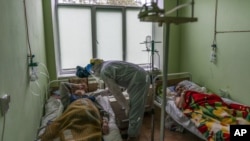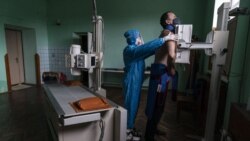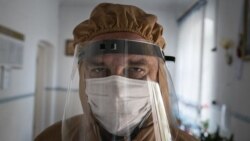The number of coronavirus infections in Ukraine began rising in late summer. And the effects are now reaching towns like Stebnyk in the western part of the country. That is where Natalia Stetsik is watching the growing number of patients with much concern.
“It’s incredibly difficult,” she says, explaining that there is a serious shortage of doctors. Stetsik is the chief doctor at the only hospital in the town, which is home to 20,000 people.
The hospital normally takes 100 patients for any medical condition. But it is already at its limit, treating 106 patients with COVID-19.
Early in the coronavirus health crisis, Ukraine’s health care system struggled with the disease. And officials announced stay-at-home orders in March to prevent overcrowding at hospitals.
The number of cases slowed during the summer months but began to go up again quickly. This led to the government closing Ukraine’s borders for a month at the end of August. Yet positive tests for the virus reached 4,661 each day in the first weekend of October. That was a new daily record.
In all, COVID-19 infections in Ukraine have nearly doubled over the past month, topping 234,000.
“An increasing share (of patients) are in grave condition,” Stetsik told The Associated Press of the situation in Stebnyk. “The virus is becoming more aggressive and more difficult to deal with.”
She said many patients doing poorly are in their 30s and more of them need costly medication.
“There is a similar situation across entire Ukraine,” Dr. Stetsik explained. Hospitals have little or no money to provide drugs, which forces patients in some areas to buy their own.
The World Health Organization warns that the number of infections in Ukraine could continue to grow and reach 7,000 to 9,000 a day.
The government hopes to avoid restarting stay-at-home orders. But officials admit that the rising number of infections could make it necessary. They are aiming for a more flexible method to lessen the economic damage. It would divide the country into different zones, depending on the rate of infections.
At a meeting Monday in Kyiv, President Volodymyr Zelenskiy told officials they have done a poor job of slowing the spread of the virus. And he accused them of taking too long to provide much needed supplies.
“We spend weeks on doing things that must be done within days,” he said.
Zelenskiy urged the officials to move faster to make sure that hospitals have enough oxygen supplies. He noted that only about 40 percent of beds for COVID-19 patients have access to oxygen.
Ukraine’s economy has been weakened by corruption and a six-year conflict with Russia-supported separatists. Zelenskiy’s administration followed health care reforms enacted by the former president, who had cut government assistance. Without the aid, hospital workers were underpaid and did not have the right equipment.
Last month, Zelenskiy ordered an increase in wages for medical workers.
Official records show that 132 medical workers have died from the coronavirus. The number does not include those who tested negative but showed signs of having COVID-19.
One of those workers was 51-year-old Ivan Venzhynovych, a doctor from the western town of Pochaiv. He spoke to The Associated Press about the health crisis in May.
Venzhynovych died last week of double pneumonia, which his coworkers believed was caused by the virus. However, he had tested negative.
“He certainly had COVID-19,” said his wife Iryna, a doctor at the hospital where he worked. “There are many infections among medical workers, some of them confirmed and others not.”
The government pays $56,000 to families of medical workers who die from the virus. But Venzhynovych’s wife cannot get the money because he tested negative.
As the number of cases grows, many lawmakers and top officials are testing positive, including former President Petro Poroshenko. He was hospitalized in serious condition with pneumonia.
Medical experts want the government to bring back strong social restrictions. They point to a lack of resources in the health care system.
Dr. Andriy Gloshovskiy is a surgeon at the hospital in Stebnyk. But he now treats COVID-19 patients because of the doctor shortage. He blamed new infections on the public’s lack of concern about the virus.
Health Minister Maxim Stepanov said Ukraine may increase the number of people hospitals can take and improve oxygen supplies. “But we could just be simply short of doctors. Every system has its limit,” he said.
A harsh lockdown would be a severe hit to the already weakened economy, Stepanov said. But he warned that officials could be forced to do it anyway.
I’m Alice Bryant.
The Associated Press reported this story. Alice Bryant adapted it for VOA Learning English. George Grow was the editor.
________________________________________________________________
Words in This Story
positive – adj. showing the presence of a particular germ, condition, or substance
grave – adj. very serious
flexible – adj. willing to change or to try different things
zone – n. an area that is different from other areas in a particular way
access – v. a way of being able to use or get something
negative – adj. not showing the presence of a particular germ, condition, or substance
pneumonia – n. a serious disease that affects the lungs and makes it difficult to breathe
resource – n. a supply of something (such as money) that someone has and can use when it is needed
surgeon – n. a doctor who performs operations that involve cutting into someone's body in order to repair or remove parts
lockdown – n. a state of isolation or restricted access launched as a security or health measure










